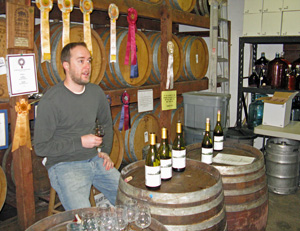I’ve posted a portion of a report from mid-January visits to several Santa Cruz Mountains wineries and tasting rooms during their Passport Weekend. Several wineries shared locations for pouring their wines. A full report on all of the visits – with tasting notes and more photos – is on the Grape-Nutz.com website:
Santa Cruz Mountains - January 2013
McHenry Vineyard
Equinox Wines / Trout Gulch Vineyard / Copious Winery
Downhill Cellars / Muccigrosso Vineyards / Byington Winery

McHenry Vineyard
Just a mile or so north of Bonny Doon, we headed up a small side road where we soon came upon McHenry Vineyard. Passing alongside the vineyard, surrounded by soaring trees, we parked next to a small wooden building that houses the winery and we walked inside. The winery was founded by Dean McHenry – the first chancellor of UC Santa Cruz – and his wife Jane, along with their son and daughter-in-law Henry and Linda. Linda had studied viticulture at UC Davis, and Henry, who was a noted anthropology professor there, learned winemaking from his Davis colleagues. Dean passed away in 1998 but Jane celebrated her 100th birthday last year. The vineyard and winery are still family-run, and Henry’s son Ian McHenry and son-in-law Brandon Blanchard were on hand in the winery to pour three recent Pinot Noir releases and two older bottlings.
McHenry Vineyard produces only Pinot Noir. The estate vineyard was first planted in 1972, one of the oldest Pinot plantings in the area. It was originally about four acres in size and had included Chardonnay as well as Pinot at first, but it is now entirely Pinot Noir. The vineyard is sited on a gentle slope at just under 1,800-foot elevation and less than five miles from the ocean. The topsoil is shallow, with sandstone below. The first Pinot harvest was in 1976, and the first commercial release from the winery was in 1980.
Unfortunately, like a number of other vineyards in this area, McHenry Vineyard was devastated by Pierce’s Disease in the early 1990s. It was replanted in 1997-98 with four Pinot clones – Pommard, Swan, 13, and 115. The winery continued to make wine with purchased fruit in the 1990s until the first vintage of Pinot from the replanted estate vineyard was produced in 2000. The vineyard is currently 2½ acres in size, but the McHenrys are planning to plant more Swan clone vines there, as these have produced particularly good wine at their site.
We started our tasting with two Pinots from the 2010 vintage, their regular estate wine and then a special estate “Swan Clone” bottling composed mostly of fruit from the Swan clone vines (there’s also some of the 13 clone blended in). The McHenrys are very happy with their 2010 Pinots, noting that the growing conditions were exceptional at their vineyard that year. The fruit ripened well, with brix mostly in the mid-24 range, while retaining very good acidity, with 3.3pH and 0.9TA at harvest. Both of these wines were very good, with the “Swan Clone” bottling having greater depth and complexity.
We continued with the 2009 estate Pinot – this showed the smoky effects of a summer fire close to the vineyard that year. While I can’t say that I enjoyed the smoky aroma and finish of this wine, Ian and Brandon said that it has actually been fairly popular among a number of their customers who report that it goes well with barbecued food! We finished with two wines from 1999 that were made with purchased fruit. One was from Massaro Vineyard in Carneros – McHenry made a Pinot Noir from this vineyard from 1993 through 2000 – and the other was from Amaya Ridge Vineyard in the Santa Cruz Mountains north of Soquel. I thought the 1999 Massaro bottling was a bit past its prime, but the Amaya Ridge Pinot was holding up nicely.
The tiny winery building holds the entire McHenry production. Ian and Brandon told us that in a good vintage such as 2012, they’ll produce around 500 cases, but significantly less in a tougher year like 2011. In addition to wines from recent vintages, the winery holds back a limited amount of older wines, including the two 1999 wines we tasted, and also including selected older vintages of estate Pinots.
Bryan picked up a bottle of 2010 McHenry Pinot for us to share during lunch, which we enjoyed on some patio chairs just outside the winery. McHenry is a modest operation in every sense of the word, and the family-run nature of the business was very apparent at their Passport open house. I had tried a couple of McHenry Pinot Noirs at past Santa Cruz Mountains Pinot tastings and liked them, but I thought both of their 2010 Pinots were a step up from those earlier vintages. McHenry is such a small label that it’s easy to overlook them amongst the larger and better-known Santa Cruz Mountains Pinot Noir producers, but their 2010 Pinots show that they’re capable of making some standout wines.
Current releases and library wines
McHenry 2010 Pinot Noir, Estate, Santa Cruz Mountains. Medium-light garnet color, with very pretty floral notes along with strawberry and cherry fruit, tea leaf, and earth aromas. Medium-light bodied with lively acidity and fairly mild tannins, nice.
McHenry 2010 Pinot Noir, “Swan Clone,” Estate, Santa Cruz Mountains. Slightly darker color, featuring deeper black cherry and raspberry fruit, more earth and dried herb notes, plus a touch of baking spice and a savory, meaty component. A bit bigger and more structured in the mouth, with great acidity and a long finish, very nice.
McHenry 2009 Pinot Noir, Estate, Santa Cruz Mountains. Lighter garnet color, this had an obviously smoky nose along with red fruits and spice in the background. Medium-light weight on the palate, the charcoal-like smoke returned in a big way on the finish.
McHenry 1999 Pinot Noir, Massaro Vineyard, Carneros. Medium-light color, showing funky, earthy aromas along with a darker fruit profile than the recent Santa Cruz Mountains bottlings. Still retaining good acidity and finishing with moderate tannins, but the fruit is fading.
McHenry 1999 Pinot Noir, Amaya Ridge Vineyard, Santa Cruz Mountains. Medium-light garnet color, this displayed earthy but bright black cherry fruit, tea leaf, and a touch of baking spice. Lively on the palate and finish, this has matured nicely.
